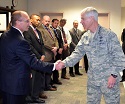USAF moving toward a common information infrastructure

Air Force Network Integration Center members here completed the migration of all user accounts onto the Air Force Network on March 31, said an article posted on an Air Force Web site.
This accomplishment marked a major milestone in the Air Force’s progression to the Department of Defense’s Joint Information Environment, a network construct that should eventually unite the entire military around a single set of shared infrastructure and information technology services.
“This is truly a significant milestone for Air Force cyberspace,” said Gen. William Shelton the commander of Air Force Space Command. “Completing this portion of the migration not only paves the way to the JIE [Joint Information Environment] for us, it is also critically important to our future enterprise and to the defense of Air Force networks on a global scale.”
Prior to the AFNET vision, unique mission requirements, operational concerns and mission-related preferences drove many Air Force organizations to create separate individual networks to support their email and applications. This patchwork of networks led to high operational and maintenance costs, not to mention standardization and security challenges across the service.
“Until now, organizations across the Air Force have been operating what were essentially their own independent networks, consequently driving unique and unit specific requirements,” said Markus Rogers, the director of network architectures and lead of AFNET migration. “The AFNET means enterprise-class situational awareness, network scalability and an ability to command and control our network.”
The AFNET migration project consolidated 646,000 email boxes and 12,318 servers at 275 sites from multiple Air Force major commands, field operating agencies, direct reporting units and geographically separated unit networks. It created a centrally-managed standardized structure under the operational control of the 24th Air Force commander.
This large-scale project took a team of more than 200 military, civilian and contractor personnel from AFNIC and the 690th Cyberspace Operations Group five years to complete.








